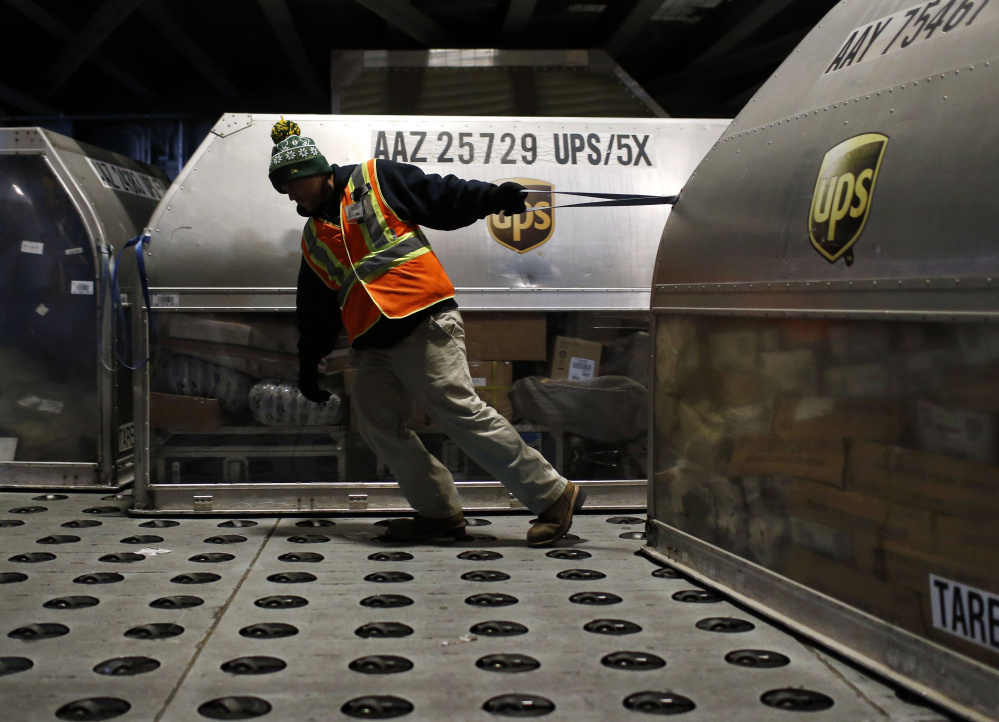WASHINGTON — Growth in online shopping was especially strong this holiday season, a shift in behavior that put heavy pressure on the supply chains of FedEx and UPS.
This year, amid a patch of inclement weather in the days just before Christmas, the shipping giants struggled to deliver a crush of last-minute gifts onto customers’ doorsteps in time for the holiday. According to data released Tuesday by ShipMatrix, on-time delivery performance for FedEx’s overnight service sank to 77 percent on Dec. 23, compared with the 95.2 percent on-time performance the company had achieved two days earlier. UPS experienced a similar dip, with only 79.5 percent of packages delivered on time Dec. 23, down from 94 percent Dec. 21.
Both carriers rebounded with better on-time performance on Christmas Eve. FedEx had a 96.2 percent on-time performance; UPS was at 97.7 percent. ShipMatrix also found that both companies made deliveries on Christmas Day to keep up with the crush of eleventh-hour shipments. FedEx said it also expanded its operations the day after Christmas to get delayed packages to their recipients.
FedEx said in a statement that in the final run-up to Christmas, it “handled package volume that exceeded previous records, including a surge of last-minute e-commerce shipments.”
The findings underscore the challenges facing retailers and shippers as more shopping dollars move online. The fast-paced but not-always-predictable growth in this channel has made it difficult to forecast the volume of packages that will hit a shipping network on a given day, especially during the busy holiday season.
In explaining what caused delivery snags at UPS earlier this holiday season, chief executive David Abney said Tuesday in a CNBC interview that there was a discrepancy between company expectations and actual package volume.
“Going into Cyber Week, we had good plans,” Abney said. “Then Cyber Weekend and Cyber Monday, the volume – I wouldn’t say surged throughout the network, but in two or three primary locations we got much more volume than we originally thought.”
Satish Jindel, president of ShipMatrix, said exasperated customers should keep in mind that even a near-perfect performance by shippers would mean legions of procrastinating shoppers would not get their package on time. Between FedEx, UPS and the U.S. Postal Service, Jindel said more than 60 million packages were delivered on Christmas Eve. At that massive volume, even if the carriers achieved 99 percent on-time performance, that still means 600,000 packages would not have made it to their recipients in time.
The shippers are working to make changes big and small to their strategies in order to adapt to the growth of e-commerce. FedEx said on its most recent earnings call that the rise of online shopping has meant it is making more deliveries to residential addresses, which translates into more stops, greater fuel costs and a change in the mix of the dimensions of the packages it is moving.
This is likely one reason why UPS moved this year to add 8,000 of its so-called Access Points – places such as UPS stores or local grocery stores where shoppers can pick up their packages instead of having them delivered to their front door. UPS touts Access Points as a service to customers that gives them flexibility about when to retrieve a package or that allows them to avoid worrying about having a package stolen. But if Access Points become popular, they’re also an efficiency-builder for UPS, because it is much speedier and simpler for UPS to deliver 10 packages to a single grocery store than to deliver those same 10 packages to 10 homes.
Copy the Story LinkSend questions/comments to the editors.





Success. Please wait for the page to reload. If the page does not reload within 5 seconds, please refresh the page.
Enter your email and password to access comments.
Hi, to comment on stories you must . This profile is in addition to your subscription and website login.
Already have a commenting profile? .
Invalid username/password.
Please check your email to confirm and complete your registration.
Only subscribers are eligible to post comments. Please subscribe or login first for digital access. Here’s why.
Use the form below to reset your password. When you've submitted your account email, we will send an email with a reset code.